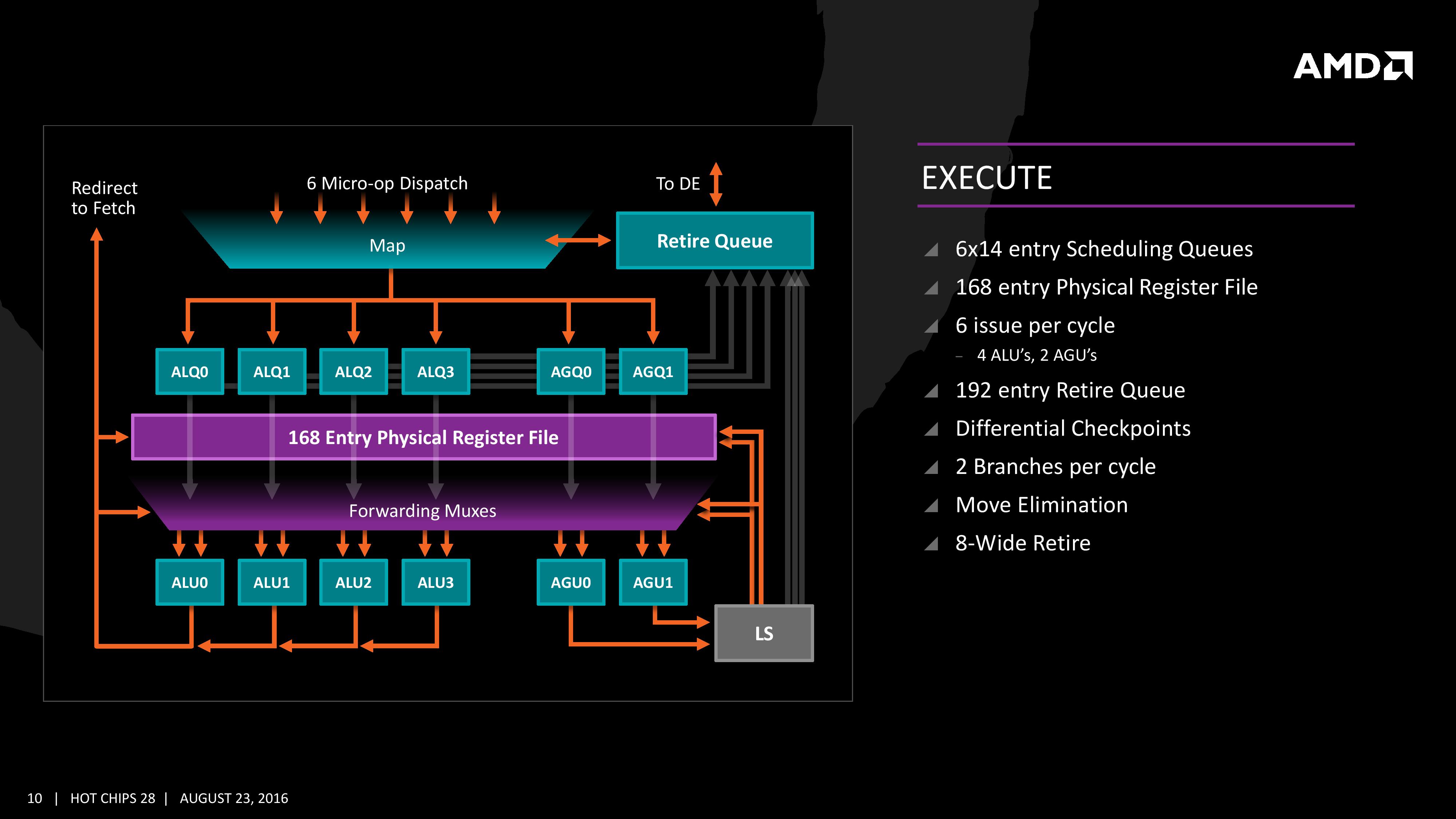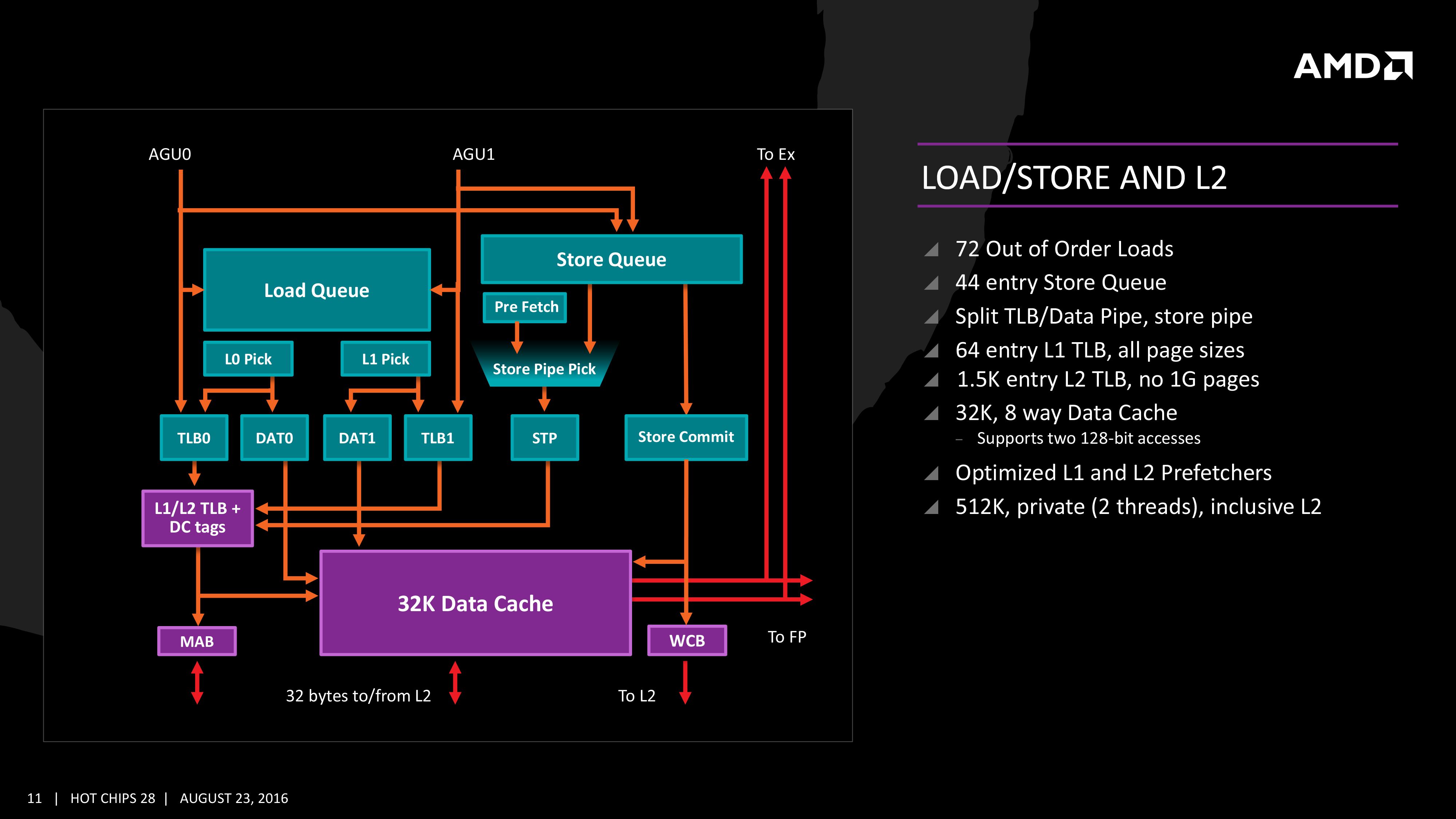The AMD Zen and Ryzen 7 Review: A Deep Dive on 1800X, 1700X and 1700
by Ian Cutress on March 2, 2017 9:00 AM ESTExecution, Load/Store, INT and FP Scheduling
The execution of micro-ops get filters into the Integer (INT) and Floating Point (FP) parts of the core, which each have different pipes and execution ports. First up is the Integer pipe which affords a 168-entry register file which forwards into four arithmetic logic units and two address generation units. This allows the core to schedule six micro-ops/cycle, and each execution port has its own 14-entry schedule queue.
The INT unit can work on two branches per cycle, but it should be noted that not all the ALUs are equal. Only two ALUs are capable of branches, one of the ALUs can perform IMUL operations (signed multiply), and only one can do CRC operations. There are other limitations as well, but broadly we are told that the ALUs are symmetric except for a few focused operations. Exactly what operations will be disclosed closer to the launch date.
The INT pipe will keep track of branching instructions with differential checkpoints, to cut down on storing redundant data between branches (saves queue entries and power), but can also perform Move Elimination. This is where a simple mov command between two registers occurs – instead of inflicting a high energy loop around the core to physically move the single instruction, the core adjusts the pointers to the registers instead and essentially applies a new mapping table, which is a lower power operation.
Both INT and FP units have direct access to the retire queue, which is 192-entry and can retire 8 instructions per cycle. In some previous x86 CPU designs, the retire unit was a limiting factor for extracting peak performance, and so having it retire quicker than dispatch should keep the queue relatively empty and not near the limit.
The Load/Store Units are accessible from both AGUs simultaneously, and will support 72 out-of-order loads. Overall, as mentioned before, the core can perform two 16B loads (2x128-bit) and one 16B store per cycle, with the latter relying on a 44-entry Store queue. The TLB buffer for the L2 cache for already decoded addresses is two level here, with the L1 TLB supporting 64-entry at all page sizes and the L2 TLB going for 1.5K-entry with no 1G pages. The TLB and data pipes are split in this design, which relies on tags to determine if the data is in the cache or to start the data prefetch earlier in the pipeline.
The data cache here also has direct access to the main L2 cache at 32 Bytes/cycle, with the 512 KB 8-way L2 cache being private to the core and inclusive. When data resides back in L1 it can be processed back to either the INT or the FP pipes as required.
Moving onto the floating point part of the core, and the first thing to notice is that there are two scheduling queues here. These are listed as ‘schedulable’ and ‘non-schedulable’ queues with lower power operation when certain micro-ops are in play, but also allows the backup queue to sort out parts of the dispatch in advance via the LDCVT. The register file is 160 entry, with direct FP to INT transfers as required, as well as supporting accelerated recovery on flushes (when data is written to a cache further back in the hierarchy to make room).
The FP Unit uses four pipes rather than three on Excavator, and we are told that the latency in Zen is reduced as well for operations (though more information on this will come at a later date). We have two MUL and two ADD in the FP unit, capable of joining to form two 128-bit FMACs, but not one 256-bit AVX. In order to do AVX, the unit will split the operations accordingly. On the counter side each core will have 2 AES units for cryptography as well as decode support for SSE, AVX1/2, SHA and legacy mmx/x87 compliant code.













574 Comments
View All Comments
EchoWars - Thursday, March 2, 2017 - link
No, apparently the failure was in your education, since it's obvious you did not read the article.Notmyusualid - Friday, March 3, 2017 - link
Ha...sharath.naik - Thursday, March 2, 2017 - link
I think you missed the biggest news in this information dump. The TDP is the biggest advantage amd has. Which means that for 150watt server cpu. they should be able to cram a lot more cores than intel will be able to.Meteor2 - Friday, March 3, 2017 - link
^^^This. I think AMD's strength with Zen is going to be in servers.Sttm - Friday, March 3, 2017 - link
Yeah I can see that.UpSpin - Thursday, March 2, 2017 - link
According to a german site, in games, Ryzen is equal (sometimes higher, sometimes lower) to the Intel i7-6900K in high resolution games (WQHD). Once the resolution is set very low (720p) the Ryzen gets beaten by the Intel processor, but honestly, who cares about low resolution? For games, the probably best bet would be the i7-7700K, mainly because of the higher clock rate, for now. Once the games get better optimized for 8 cores, the 4-core i7-7700K will be beaten for sure, because in multi-threaded applications Ryzen is on par with the twice expensive Intel processor.I doubt it makes sense to buy the Core i7-6850K, it has the same low turbo boost frequency the 6900K has, thus low single threaded performance, but at only 6 cores. So I expect that it's the worst from both worlds. Poor multi-threaded performance compared to Ryzen, poor single threaded performance compared to i7-7700K.
We also have to see how well Ryzen can get overclocked, thus improving single core performance.
fanofanand - Thursday, March 2, 2017 - link
That is a well reasoned comment. Kudos!ShieTar - Thursday, March 2, 2017 - link
Well, the point of low-resolution testing is, that at normal resolutions you will always be GPU-restricted. So not only Ryzen and the i7-6900K are equal in this test, but so are all other modern and half-modern CPUs including any old FX-8...The most interesting question will be how Ryzen performs on those few modern games which manage to be CPU-restricted even in relevant resolutions, e.g. Battlefield 1 Multiplayer. But I think it will be a few more days, if not weeks, until we get that kind of in-depth review.
FriendlyUser - Thursday, March 2, 2017 - link
This is true, but at the same time this artificially magnifies the differences one is going to notice in a real-world scenario. I saw reviews with a Titan X at 1080p, while many will be playing 1440p with a 1060 or RX480.The test case must also approximate real life.
khanikun - Friday, March 3, 2017 - link
They aren't testing to show what it's like in real life though. The point of testing is to show the difference between the CPUs. Hence why they are gearing their benchmarking to stress the CPU, not other portions of the system.